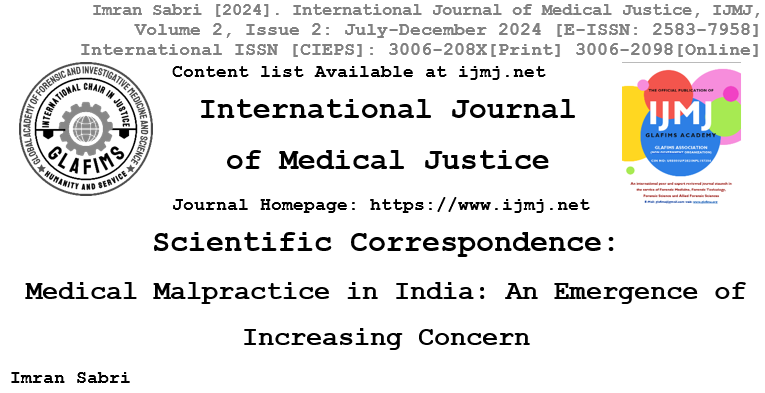Medical Malpractice in India: An Emergence of Increasing Concern
DOI:
https://doi.org/10.5281/zenodo.14254169Keywords:
Medical MalpracticeAbstract
As awareness regarding patients’ rights continues to expand, the increase in instances of medical malpractice has prompted India's medical regulatory bodies to remain vigilant, with bereaved patients and advocates asserting that the pursuit of justice is fraught with challenges. Medical malpractice, characterized as the failure of a healthcare provider to uphold an acceptable standard of care, remains a pressing issue in India. Notwithstanding the availability of legal avenues, numerous obstacles impede the effective prosecution of medical malpractice cases within the country. The data indicates that the annual incidence of medical malpractice in India reaches 5.2 million cases. The frequency of such incidents has escalated by 110%; meanwhile, litigation has surged by 400%. This paper reviewed the frequency of medical malpractice occurrences, the existing legal framework designed to address these issues, and the difficulties encountered in obtaining compensation. It further deliberates on potential strategies to enhance patient safety and diminish the prevalence of malpractice incidents. The conclusion drawn is that medical malpractice represents a significant challenge in India, adversely impacting both patient safety and trust in the healthcare system. Legal actions regarding medical malpractice should serve to deter negligence while ensuring that victims receive compensation that is equitable, prompt, cost-effective, and readily accessible. To bolster patient safety and mitigate malpractice risks, a variety of solutions warrant exploration.

Downloads
Published
How to Cite
Issue
Section
License
Copyright (c) 2024 International Journal of Medical Justice

This work is licensed under a Creative Commons Attribution 4.0 International License.
Copyright Policy Summary – International Journal of Medical Justice (IJMJ):
IJMJ is an open access journal. All articles are published under the Creative Commons Attribution 4.0 International License (CC BY 4.0). This allows others to freely access, share, reproduce, and create derivative works, provided proper credit is given to the original authors. Authors retain full ownership of their work.

